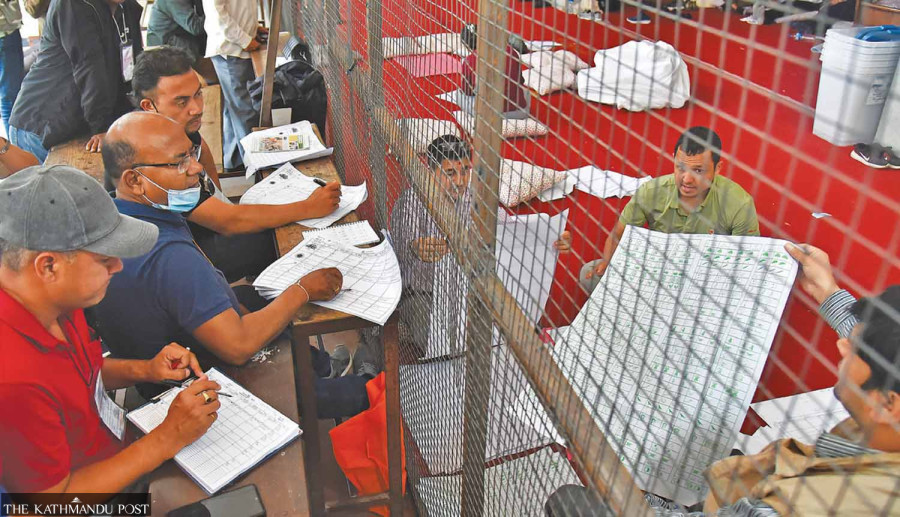National
Sluggish vote counting calls for switching to tech-friendly elections
The pace at which ballot papers of municipal elections are being counted is tiring and cumbersome and is a source of controversy, observers say.
Tika R Pradhan
On January 14, the Election Commission had proposed holding local elections on April 27, if they were to be held in one go, or on April 27 and May 5, if in two phases.
The commission said that the tenure of the elected local representatives would expire on May 19, as the first phase of the last local elections in 2017 were held on May 14, and it would need about 100-120 days for preparations. However, the government announced local polls for May 13. Commission officials believed that the results would be out by May 18 so as not to let local units remain without representatives.
The commission conducted local elections on May 13 (Friday), by and large successfully, and now vote counting is underway. However, the counting has been so sluggish that it might take more than a week for the final results to come in.
Chief Election Commissioner Dinesh Thapaliya on Saturday said that at least 10 days would be required to conclude the counting, contrary to his earlier claim that the commission would complete all the counting within five days.
Once again, questions now are being asked why the Election Commission is still reluctant to adopt the electronic voting system and why it still relies on the traditional way of voting through ballot papers, which were too complicated this time—not only for the voters but also for the tellers.
Observers and political leaders say it is high time Nepal switched to electronic voting machines which would save resources, and most importantly the time involved in the counting process.
“It’s just a tiring and cumbersome process… a large number of people—supporters, voters, and the candidates—have sleepless nights during the counting,” said Neil Kantha Uprety, former chief election commissioner. “And, the more delay, the more issues crop up.”
According to Uprety, the country should have gone for the electronic voting system long ago by developing its own software and voting machines.
“Even in the world of so much technological advancements, we are continuing with the elections like in the 18th century,” Uprety told the Post. “Our Nepali experts can develop software and the machines necessary for the polls and they can be used after quality assurance. We cannot afford to wait for so many days to get the results.”
It’s not that Nepal has not used electronic voting machines in the past. During the 2008 Constituent Assembly polls, such machines were used in Kathmandu Constituency 1 on a trial basis.
After the last local elections, it took 14 days for the tellers to complete the counting of votes of Kathmandu Metropolitan City. Looking at the pace of counting of votes of the Kathmandu Metropolitan City, tellers may take even more days this time, given the number of voters and the sheer size of the ballot paper. Of the little over 300,000 eligible voters, the Kathmandu Metropolitan City saw a voter turnout of 64 percent (a little over 190,000).
About three months ago, a team led by Anil Kumar Dutta, a joint secretary at the Ministry of Communication and Information Technology, had presented a report to the Election Commission saying that there won’t be any problem in using electronic voting machines.
“Many countries, including India, have been effectively using electronic voting machines. Nepal can easily use them,” Dutta told the Post. “We had recommended that the Election Commission use the electronic voting system after studying the voting system of different countries.”
According to Dutta, Nepal can use electronic voting by forming a team to aggregate voting devices as per the need of the polling constituencies.
A Carter Centre report of the 2008 Constituent Assembly polls had observed that the pilot test of electronic voting machines in Kathmandu went well, a promising sign for future elections. A year later the electronic voting machines were used in all six constituencies during the by-elections held on April 10, 2009 in Morang constituencies 5 and 7, Dhanusha, Kaski, Rolpa and in Kanchanpur.
It has been 14 years since, and the country is still relying on ballot papers and hand counting of votes.
Though Election Commission officials, including Election Commissioner Ishwari Prasad Poudyal, and some observers are in favour of electronic voting machines, politicians have a divided opinion.
“We could have used voting machines for local level polls but we cannot trust them for general elections,” said Barshaman Pun, a senior leader of the CPN (Maoist Centre). “Even developed countries have returned to traditional ballot papers. Actually we fear tampering as technology has been changing very fast and people can manipulate votes.”
Pun’s assertion, however, seems to stem from the fact that some countries are pushing for strengthening high-tech voting infrastructure with traditional papers, which does not necessarily mean completely reverting to ballot papers.
Subas Nembang, a vice-chair of the CPN-UML, which used electronic voting machines during its general convention to elect the new leadership, said his party is always for the use of the machines.
“Electronic voting could also end the risk of rigging,” he said. “There are rumours of original ballot boxes being replaced with stuffed ones in different parts of the country. If there was electronic voting, there wouldn't be such rumours.”
The UML on Sunday claimed that the local elections were rigged and accused the ruling coalition of being involved in a “planned rigging” and has demanded that the government stop electoral fraud.
“In dozens of places polling booths were captured and the ruling coalition was involved in fraud even during the vote counting,” states the press release issued by UML General Secretary Shankar Pokhrel.
Nembang believes, by adopting the electronic voting system, poll rigging can be avoided.
According to him, many of the problems, if not all, can be addressed by electronic voting as the longer it takes for the results to be out, the more complications arise.
“We had agreed on electronic voting but we don’t know why the election body did not adopt it,” Nembang told the Post. “We will press for serious discussions to shift to an electronic voting system at the earliest.”
He said the way counting is being done within wire fences in many places is a mockery of the country’s system and democracy.
The reasons behind the parties’ reluctance to adopt newer technologies in voting, according to Uprety, the former chief election commissioner, are that they think they cannot rig votes and invalid votes may also help them win and all those chances will end if electronic voting system is used.
“Even for ensuring the integrity of the elections we need to adopt new technologies,” Uprety said. “We can start by adopting the electronic voting system in some constituencies as a pilot project in the upcoming federal and provincial polls.”
Even during the 2017 federal and provincial polls, the Election Commission had discussed with the parties about using the electronic voting system but the parties, especially the Nepali Congress, the UML and the CPN (Maoist Centre), rejected the idea after the commission failed to convince them.
The Congress went the traditional way of voting during its general convention to elect the new leadership. Voting was out of question in the Maoist Centre’s general convention as its chair handpicked the office bearers.
Election Commission officials say they were forced to continue with the traditional voting system because, on the one hand, there was no time for them to manage voting machines and, on the other hand, the political parties were not ready for it.
“The Election Commission has for long been saying that we should switch to the electronic voting system,” said Poudyal, the election commissioner. “It needs a big budget only for the first time. But ultimately, elections become cost effective.”
There, however, are some prerequisites.
“Firstly, parties need to agree to use electronic voting machines,” said Poudyal. “And it needs time. Voters must get ample time to practise how to vote using voting machines.”




 8.12°C Kathmandu
8.12°C Kathmandu


%20(1).jpg&w=200&height=120)












